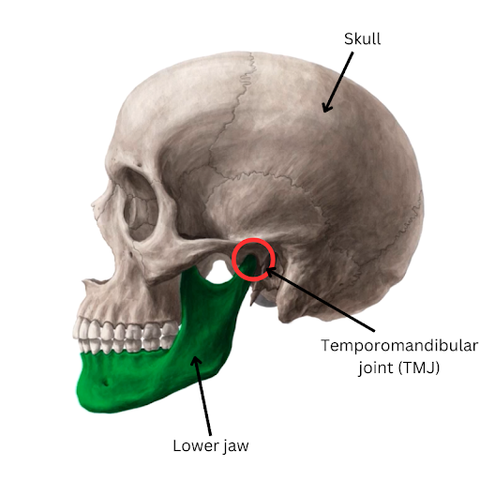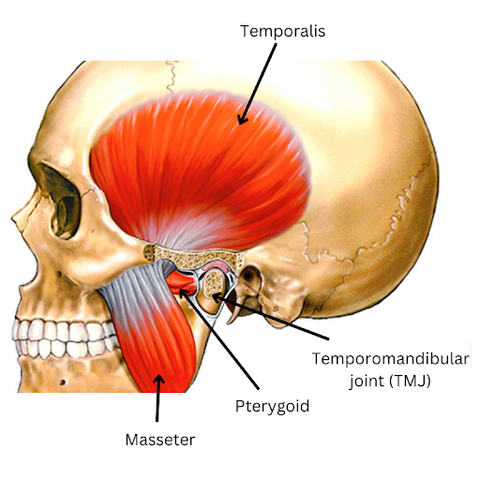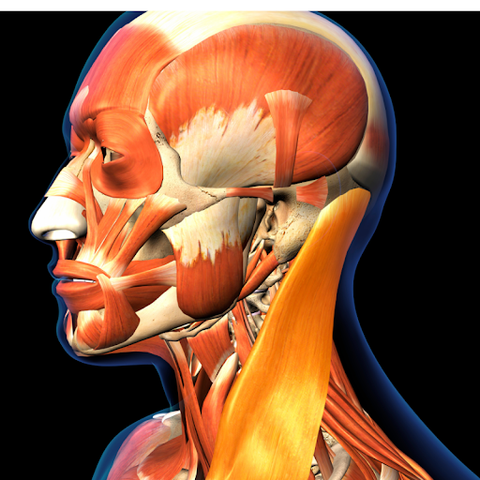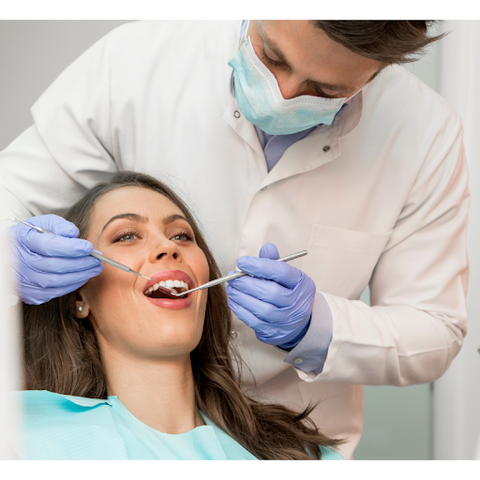Teeth grinding can lead to migraines. Teeth grinding employs enormous force, which puts enormous strain on the TMJ muscles, causing a throbbing pain that stretches to the side of the head to cause migraines.
Do you often experience headaches, especially severe throbbing pain on one side of your head? While headaches may have become normal to many people, these aches are often a symptom of something else.
Teeth grinding may be the culprit of your migraine bouts. If you wake up with a sore jaw or a chalky taste in your mouth, teeth grinding while sleeping may be the cause of your migraines.
This article discusses the link between teeth grinding and migraines. It explains how teeth grinding can lead to a migraine, how to know if your migraines are from teeth grinding, and how to alleviate migraines caused by teeth grinding.
At the end of this article, you’ll be one step closer to protecting your teeth from uncontrolled grinding at night and having a tension-free sleep.
HOW DOES TEETH GRINDING LEAD TO MIGRAINES?
Teeth grinding puts enormous force on the temporomandibular joint (which connects the jaw to the skull) and supporting muscles.
These muscles are far-reaching, stretching from the jaw to the side of the head. Excessive strain on them leads to throbbing pain along their path, including the side of the head.
Thus, teeth grinding leads to migraines in four processes:
- It generates enormous force.
- The force places strain on the TMJ muscles.
- The strain on the TMJ muscles causes throbbing pain along their path, which includes the side of the head.
- The throbbing pain becomes migraines.
Let’s discuss this in detail.
TEETH GRINDING GENERATES ENORMOUS FORCE
Jaw clenching and teeth grinding often occur together. Teeth clenching means bringing the top and bottom teeth together and tightening the jaw muscles to hold the teeth in a tight vice-like grip.
Teeth grinding means moving the teeth back and forth (in a chewing motion) while clenched.
Some grinding occurs naturally when we eat. But some people may suffer from involuntary and excessive teeth clenching and grinding, especially during sleep. This is a medical condition called bruxism.
Bruxism (involuntary teeth grinding) employs enormous force – more than 10 times the force employed by normal chewing. While normal biting and chewing generate forces between 13 – 23 pounds (5.9 – 10.43 kg), involuntary teeth grinding employs as much as 250 pounds (113.4 kg) of force.
Think of having a weight 10 times more than you can carry placed on you! While our jaws are powerful, the forces employed by involuntary teeth grinding (bruxism) overwork them.
THE FORCE FROM TEETH GRINDING PUTS ENORMOUS STRAIN ON THE TMJ MUSCLES
Involuntarily grinding and clenching teeth involves excessively tightening the jaw. So this places enormous strain on the two joints connecting the lower jaw to the skull, which are known as the temporomandibular joints (TMJ).

The temporomandibular joints (TMJ) are surrounded by strong muscles. These muscles’ contracting and relaxing actions control the movement of the jaw, enabling various actions such as talking, yawning, chewing, sucking, swallowing, breathing, etc.
The enormous strain on the temporomandibular joints also causes enormous strain on these TMJ muscles.
THE STRAIN ON THE TMJ MUSCLES CAUSES THROBBING PAIN ALONG THEIR PATH
Excessive use or stress causes muscle aches and pains. This explains why your muscles feel sore after exercise or hard physical work.
The involuntary teeth grinding overuses the TMJ muscles, placing enormous strain on them. This makes the TMJ muscles sore, ultimately resulting in aches and pain.
The ache spreads out, reaching every area where the TMJ muscles reach. Interestingly, the TMJ muscles stretch to reach the side of the head.
The four TMJ muscles and their locations are as follows:
- Masseter: The masseter, which is responsible for elevating the mandible to close the mouth, attaches to the mandible (the lower jaw).
- Pterygoids: There are two pterygoid muscles (media pterygoid and lateral pterygoid), and they are located around the temporomandibular joint.
Temporalis: The temporalis, a fan-shaped muscle that retracts the mandible, is located on the lateral side of the skull.

Thus the temporomandibular joint (TMJ) muscles are far-reaching, stretching from well below the lower jaw to the side of the head, near the top.
So when bruxism overly strains these muscles, the resulting pain primarily courses through the jaw up to the side of the head.
Also read: 5 Best Mouth Guards For TMJ (Ranked!)
THE THROBBING PAIN COULD BECOME A MIGRAINE
When bruxism causes the TMJ muscles along the side of the head to ache, you may feel dull headaches. The headache can linger and even grow to throbbing pain. That could be a migraine – a headache that causes throbbing pain, usually on one side of the head.
The trigeminal nerve system also aggravates the headache. The trigeminal nerve is the part of the nervous system that sends pain, touch, and temperature sensations from your face to your brain.
During the brutal activity of bruxism on the TMJ muscles, the trigeminal nerve is bombarded with “pain” signals, which it sends to the brain, stimulating the fluid surrounding the brain to give you a pounding headache.
Thus, bruxism can cause headaches. Different scientific studies have confirmed the association between bruxism and migraines.
An earlier 2013 study concluded that the association between sleep bruxism and painful temporomandibular disorders greatly increased the risk for episodic migraines, especially chronic ones.
A more recent study (2021) analysed 544 studies evaluating the association between bruxism and headaches and concluded that people with awake bruxism have a 5 – 17 times more chance of having tension headaches.
HOW DO I KNOW IF MY MIGRAINES ARE FROM TEETH GRINDING?
First of all, why should you be interested in knowing whether your migraines are from teeth grinding? Shouldn’t you just take medication without worrying about the cause of the migraines?
No, you shouldn’t! Because the medication cannot give a lasting solution if the migraine is a symptom of an underlying problem.
You may get temporary relief. But when you sleep, bruxism will seize control of your teeth and give them an intense grinding. Then you’ll wake up with another bout of headaches that can become migraines.
Determining whether your migraines are from teeth grinding is simply finding the underlying cause of the problem, allowing you to tackle the problem from its source to get a lasting solution.
Thankfully, there are several signs that are pointers to bruxism-caused migraine. These include:
- Symptoms pattern
- Jaw clenching or teeth grinding movement during sleep
- Dental issues
- Sensitive teeth
- Reduced oral function
- Physical symptoms like earaches, sinus pains, and stiff necks
- Location of the pain
- Medical examination
Let’s explore them in detail.
SYMPTOMS PATTERN
Involuntary teeth grinding occurs mainly during sleep. So, if you experience migraines in the morning or upon waking up from sleep, they may be caused by teeth grinding.
So, one of the easiest ways to know if your migraines are from teeth grinding is to note the pattern of the migraine attacks.
Keeping a headache diary can help in this regard. Note down when you felt the headache, its intensity, what you were doing before it started, and any other relevant information.
JAW CLENCHING OR TEETH GRINDING MOVEMENT DURING SLEEP
Though bruxism during sleep causes the teeth to pummel each other with deadly force, you may be unaware that you are clenching or grinding your teeth. However, a bed partner may hear the grinding or see the visible mouth movement.
Thus, asking a partner whether you grind your teeth during sleep can help you determine whether your migraines are from teeth grinding.
DENTAL ISSUES
Teeth grinding causes a host of dental issues. For example, it causes rapid tooth wear. Tooth-to-tooth contact wears down the tooth enamel.
Bruxism brings the teeth into contact more than they should, causing the enamel to wear down quickly. In fact, people who suffer from bruxism can experience up to 2mm enamel erosion by their 20s.
Excessive enamel loss can leave teeth more susceptible to cavities and tooth decay. The tooth enamel is your first line of defence against cavities. But when it wears away, it’s easier for plaque and bacteria to damage your teeth and cause cavities.
The intense force employed in gritting and grinding the teeth can also result in cracking and chipped teeth.
So, if you have migraine headaches when battling dental issues (such as cavities, abscesses, etc.), the headache may be from teeth grinding.
SENSITIVE TEETH
When suffering from sensitive teeth, normal activities like brushing and eating can cause sharp (albeit temporal) pain in your teeth. Worn tooth enamel (which is facilitated by teeth grinding) is one of the main causes of sensitive teeth.
Bruxism symptoms and side effects like a cracked tooth, chipped tooth, and cavities also cause sensitive teeth.
So, when suffering migraines, do you also notice pain or discomfort in your teeth as a response to certain stimuli? If so, the migraine may be a tension headache from bruxism.
REDUCED ORAL FUNCTION
The operation of the temporomandibular joints and surrounding muscles enables several oral functions, including chewing, sucking, swallowing, talking, yawning, etc.
The muscle tension from excessive teeth clenching and grinding causes pain all over the place, which may compromise oral functions associated with these systems.
For example, you may be unable to open your mouth wide or swallow because of jaw pain.
That said, your migraine may be from teeth grinding if you are experiencing reduced oral function in addition to the throbbing headache.
OTHER PHYSICAL SYMPTOMS
Bruxism can result in other symptoms like earaches, neck pain, and more. The TMJ muscles affect many other muscles around the head and neck.
When bruxism strains the TMJ muscles, the tension spreads to these ”secondary” muscles, and they, too, become sore.
Thus, the pain resulting from teeth grinding and clenching can also be felt throughout the face, ear, neck, and shoulder.

So, when you have a migraine attack, look out for other physical symptoms like earaches, facial soreness, sinus pain, and stiff neck. If you experience any of these symptoms while having migraines, it is possible that the throbbing headache may be from teeth grinding.
LOCATION OF THE PAIN
The sites of bruxism headaches are usually the forehead, temples, and behind the eyes. This is because these headaches are caused by tension in the TMJ muscles around those areas.
So, your migraines may be a tension-type headache caused by teeth grinding if the throbbing pain is not in the back of your head but at the forehead, temples, or behind your eyes.
MEDICAL EXAMINATION
Going for a medical examination may be the best way to determine whether your migraines are from teeth-grinding. This is because professionals can detect what you may be unable to detect in determining the cause of the problem.
For example, enamel erosion while experiencing migraines point to teeth grinding as the cause of the pulsating headaches.
While you may be unable to see the visible signs of enamel erosion due to excessive teeth grinding, a dentist can easily detect them.

HOW DO I TREAT MIGRAINES CAUSED BY TEETH GRINDING?
There are several ways to treat migraines caused by teeth grinding. These include:
- Use a night guard or mouth guard
- Get good sleep
- Manage stress
- Exercise regularly
- Take Botox shots
Let’s discuss how you can utilise them in detail.
USE A NIGHT GUARD
A night guard (also known as a bite splint or occlusal splint) is a dental appliance that serves as a cushioning barrier between your teeth, thereby protecting them from the damaging effects of teeth grinding and clenching.
A night guard is one of the best treatments for migraines from teeth grinding because it tackles the problem from its source.
Night guards prevent migraines from teeth grinding by reducing the intensity of the force generated by the brutal activity.
The soft plastic material is placed between the teeth. During a bruxism episode, the intense bite force is redistributed evenly throughout the guard, reducing the force that is transmitted to the teeth.
The reduced force transmitted to the teeth and jaw does not strain these structures as much.
Less strain on the jaws and TMJ muscles means no muscle aches. No muscle aches mean no throbbing pain in your head. Hence, no migraine episodes.
Different studies highlight occlusal appliances (like night guards) as the best way to manage bruxism toward preventing its symptoms (like migraines). One systemic review of different studies mentions occlusal appliances among four interventions for effectively managing teeth grinding.
Note that night guards do not prevent or reduce the frequency of teeth clenching and grinding. They only make the activity less damaging, and they also relieve headache discomfort.
When choosing night guards, go for custom-made options like the MYMOFOSMILE night guard. These are made specially for your teeth, making them fit properly for increased comfort when you are wearing them.
You may also like: How Much Does A Night Guard Cost In Australia? (Answered!)
GOOD SLEEP HYGIENE
Teeth grinding happens more frequently in people with poor sleep patterns than in those who do.
Studies have not established a causal link between sleep disorders and bruxism, but they agree that these two are correlated.
For example, one comprehensive study investigating the association between sleep bruxism and other sleep disorders in adults concluded that “half of the adults with obstructive sleep apnea are experiencing sleep bruxism.”
Consequently, your obstructive sleep apnea could be attributed to sleep bruxism.
Thus, practising good sleep hygiene is a good start to managing bruxism and preventing the resultant migraines. Some practical ways to do this include:
LIMIT ELECTRONICS USE BEFORE BEDTIME
Television, computers, and cell phones emit “blue light,” which restrains the production of the sleep hormone, making it difficult to fall asleep. This results in harmful sleep patterns that stress your body and exacerbate teeth grinding to give you a pounding headache.
So, do not use electronics at least an hour before bedtime to avoid disrupting your sleep cycle.
AVOID CAFFEINE
Caffeine helps you stay alert because it blocks sleep-promoting receptors in the brain (known as adenosine receptors).
Clinical studies show that caffeine taken even 6 hours prior to bedtime significantly disrupts sleep. This can aggravate teeth grinding and result in pulsating headaches.
Thus, limit your caffeine intake for a healthy sleep pattern, and ensure you do not take caffeine after noon.
AVOID SMOKING AND VAPING
Nicotine is a stimulant. So, smoking will mask your exhaustion, making you press on when your body calls for rest. This stresses your body, causing sleep problems that exacerbate teeth grinding.
Thus, avoiding smoking (especially nightly smoking) can give you better sleep, reduce teeth-grinding episodes and prevent bruxism headaches.
ENSURE OPTIMAL SLEEPING CONDITIONS IN YOUR ROOM
You’ll be unable to sleep or suffer wakefulness if your room is not conducive. The disruptions affect your sleep quality and increase the chance of teeth grinding, which causes migraines.
To get quality sleep, ensure optimal sleeping conditions – ensure the room is not too hot or cold, and eliminate noise as much as possible.
MANAGE STRESS EFFECTIVELY
Increased stress and anxiety can lead to intense teeth clenching and grinding, which may cause migraines.
A clinical study investigating the association between stress and bruxism showed that once people are stressed, they have a 97% higher chance of experiencing bruxism. Thus, managing stress can help you treat bruxism and migraines.
Common stress management techniques for dealing with bruxism include Cognitive Behavioural Therapy (CBT), Biofeedback, and relaxation techniques.
COGNITIVE BEHAVIOURAL THERAPY
Cognitive behavioural therapy helps people manage problems by changing their thoughts and behaviour. CBT makes you the therapist and provides you with the tools to solve the problem you are going through.
It works for stress by allowing you to see how certain thinking and behavioural patterns can increase stress levels (both physical and emotional stress).
So, the technique helps you identify stress triggers and increase your confidence in handling stressful situations more effectively.
BIOFEEDBACK
Biofeedback is an alternative medicine technique that uses feedback from “body functions monitoring” to teach people how to change how their bodies function.
During a biofeedback session, monitoring equipment is used to monitor physiological changes in your body, such as breathing, heart rate, muscle activity, sweat, electrical brain activity, etc.
The practitioner then uses the result to suggest strategies to change how your body is functioning. This can range from simple changes (like changing how you sit, stand, or move) to altering breathing patterns to control anxiety.
Specific physiological changes that control breathing and release muscles can help you manage stress and anxiety, improve sleep, and relieve pain.
RELAXATION TECHNIQUES
A relaxation technique is any procedure that helps you relax and attain a state of increased calmness.
Slower breathing, reduced heart rate, relaxed muscles, and lower blood pressure characterise relaxation techniques.
Breathing exercises are popular relaxation techniques. Different breathing techniques exist, but many are based on taking a long, slow breath and exhaling slowly.
Meditation or mindfulness is another popular relaxation technique. It stops racing thoughts and focuses your mind on a single thing, thereby relaxing you and relieving pain.
Different clinical studies show that relaxation techniques reduce stress, anxiety, and pain levels.
One 2018 study investigated the effect of physical therapy and relaxation techniques on tension-type headaches. It concluded that both interventions achieved a decrease in all parameters of the pain (frequency, intensity, and duration).
EXERCISE REGULARLY
Regular exercise can help treat bruxism and relieve related migraines. It releases feel-good hormones that relieve minor aches and pains.
However, you do not need to hit the gym to exercise when treating bruxism.
There are many simple bruxism-specific exercises that can help you manage the condition and relieve related pains. These include:
EXERCISE WITH YOUR TONGUE
Place your tongue at the top of your mouth, close to your front teeth, and hold it in that position for as long as possible. This prevents your jaws from coming together, effectively preventing awake bruxism.
YAWNING EXERCISES
Yawn many times in a row (about 5 – 10 times), and do this multiple times daily. Yawning stretches your jaw muscles, helping to relax muscles strained by bruxism’s brutal forces. Relaxing these muscles prevent the aches that become migraines.
MASSAGE YOUR JAW
Gently massage the jaw muscles on both sides of your face. This releases tension, providing relief from sore muscles.
EXERCISE THE SHOULDERS
Roll your shoulders by raising your two hands up and rolling them backward in a circular motion. This helps your shoulders relax, making you less inclined to clench and grind your teeth.
EXERCISE YOUR NECK
Bring your chin to your chest very slowly and hold it in that position for 10 seconds.
Then slowly move your head back upward and maintain the position for 10 seconds. Repeat the exercise over and over again until your neck feels relaxed. Since the pain experienced by a migraine sufferer can also spread to the neck, relaxing the neck muscles helps relieve some pain.
GET BOTOX SHOTS
Botox is known widely as a popular beauty treatment. However, its operation as a muscle paralyser makes it effective in treating migraines caused by bruxism.
When you receive a shot of Botox, the purified protein in the injection enters the nerve, where it is broken down to form a compound that blocks chemical signals from the nerve.
Thus, Botox paralyses a muscle temporarily. Preventing the transmission of “pain” signals from the nerve means you won’t experience the pain, hence giving relief.
Different clinical studies have shown the efficacy of Botox in treating migraines.
A 2016 study reporting the history of Botox in chronic migraine showed that Botox leads to a reduction in the frequency of monthly headache days and improves the quality of life.
Note that the effect of Botox injections wears off after about 12 weeks from the occurrence of the Bruxism-induced migraines.
USE APPROPRIATE MEDICATIONS
Certain medications can help you if you suffer from bruxism and experience regular chronic headaches and other common symptoms. The most common are prescribed muscle relaxants.
As the name suggests, these medications relax the jaw muscles. When taken before sleep, these medications relax your jaw muscles, preventing your jaws from becoming hyperactive and clenching your teeth while you sleep.
The medications can also relax jaw muscles to nullify the tension brought on by the brutal forces employed in grinding teeth.
Less strain on these muscles prevents throbbing headache pain from developing. Hence, no migraines.
Different clinical studies report that muscle relaxants reduce bruxism-related motor activity. However, you should be cautious when using these medications to avoid becoming dependent.
TAKEAWAY: FIGHT BRUXISM MIGRAINES USING MYMOFOSMILE NIGHT GUARD
Do you often experience annoying migraine headaches? The cause may be bruxism – excessive teeth clenching and grinding, especially during sleep.
Yes, teeth grinding can lead to migraines. Teeth grinding employs enormous force, which puts enormous strain on the TMJ muscles, causing a throbbing pain that stretches to the side of the head.
Thankfully, there are certain signs that show that a migraine comes from teeth grinding. These include morning headaches, dental issues, sensitive teeth, reduced oral function, etc.
Treatment modalities for migraines caused by teeth grinding include using a night guard, getting good sleep, managing stress, exercising regularly, getting Botox shots, and using appropriate medications.
However, using night guards remains one of the best and most popular treatment options.
Get a high-quality night guard from a trusted provider, and you can banish the damaging effects of bruxism, especially migraines.
Interestingly, you’ll be hard-pressed to find a better night guard than the custom-made MYMOFOSMILE night guard.
Get more valuable insight into using night guards to protect your teeth and improve your quality of life by reading our article about using a night guard to protect your dental restorations: Can I Wear A Night Guard Over A Crown?



